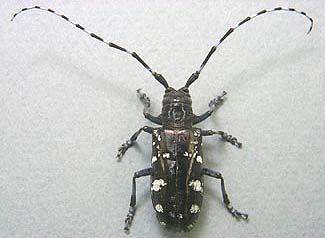
This is the Asian Longhorned Beetle, which recently hitchhiked to a warehouse in the Sacramento area from China. This is a very destructive pest, whose larvae burrow into trees, destroying the food and water "pipelines" that a tree needs to survive. Already, the Asian Longhorned Beetle has infested nearly 10,000 trees in New York, New Jersey and Illinois. The only surefire cure after an infestation? Destroy the tree in a chipper/shredder. The life cycle of the Asian Longhorned Beetle is about a year. An adult female beetle can lay 20 eggs in that time, usually in the bark of a tree. When they hatch, the larvae burrow deeper into the tree, destroying the tree's vascular system. Adult beetles emerge from the trees via a hole about the size of a dime. Adult beetles can also damage trees by chewing on the bark. Although the Asian Longhorned Beetle favors maples and elms, it is believed that the pest will take up residence in many other of California's hardwood trees, including fruit trees.
The California Department of Agriculture and the U.S. Forest Service is currently conducting a hunt for this pest near McClellan Park, in an attempt to trap and contain this voracious insect.
The adult Asian Longhorned Beetle is about an inch and a half long, bullet shaped, with distinctively colored, long antennae. The body is usually shiny black in color, with white spots.
If you spot this pest, call the California Department of Food and Agriculture's Pest Hotline: 800-491-1899.